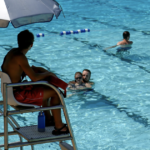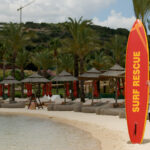The massive presence of swimmers in aquatic facilities in summer presents the need to exert PREVENTION, SURVEILLANCE, and CONTROL on them in their leisure time spent on the beaches. As a consequence of the swimming, situations will arise in which it will be necessary to act with PROMPTNESS, carry out a DIAGNOSIS and carry out an ACTION to solve the different problems that we find on the beaches.
To avoid problems and accidents on the aquatic facilities, as well as to solve them, the figure of the AQUATIC LIFEGUARD is essential for us, a figure that is becoming more and more important due to the responsibility and work that he performs: he will be the one who ensures the safety of the people at the same time will make them comply with the regulations, with the rules of use, coexistence, hygiene and internal rules of the aquatic facility. The objective of the lifeguard training and civil protection service is to improve surveillance and protect users in the event of any type of emergency that requires rapid intervention until the arrival of the health services.
Swimmers often do not know what tasks lifeguards carry out on the beaches and which are not their responsibility, which is why their work is often complicated. They are not babysitters or swingers, and even so, beach swimmers continue to ask for this type of service.
It is time for us to analyze the advantages and disadvantages of lifeguarding on our beaches to facilitate the work of these professionals:
Advantages:
- Their work is vital to maintaining safety and protecting the beaches.
- It is an integral part of the Maritime Rescue resource chain, being integrated within Civil Protection and in close collaboration with the Civil Guard Maritime Service.
- They are highly qualified people who have received specific training for open water.
- They provide health care such as minor injuries or jellyfish stings.
- They ensure the cleanliness of the water and the beach.
Disadvantages:
- The people at the beaches are unlimited while in the pools the capacity is controlled.
- The mass of water is unpredictable and the rescue personnel is subjected to sea currents with the consequent physical fatigue that comes with reaching the person for help.
- The existence of aquatic species that exist in the sea, from jellyfish to sightings of small sharks.
- Control those people who venture out to sea with the mat or those older people, who may be caught in currents or suffer a panic situation when they are far from the shore.
- Situations of confrontation between lifeguards and swimmers who fail to comply with safety warnings such as red or yellow flags or leave the entry and exit accesses of boats free.







